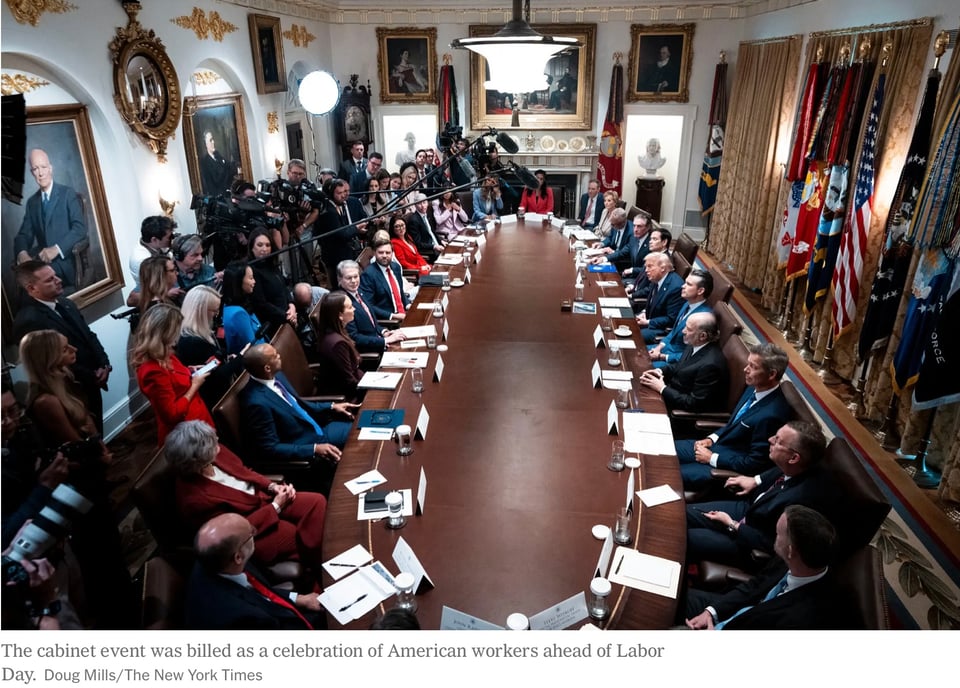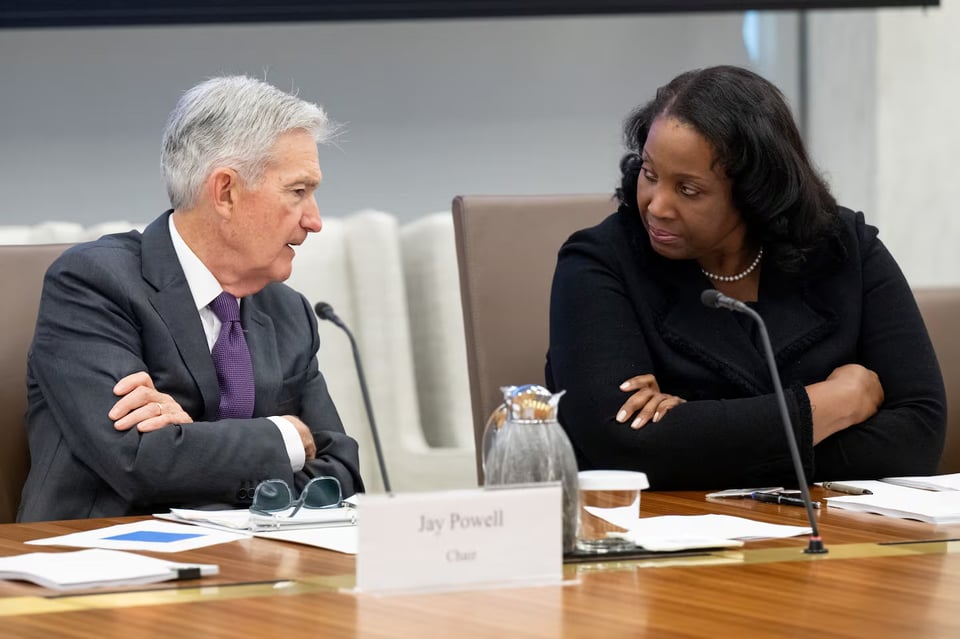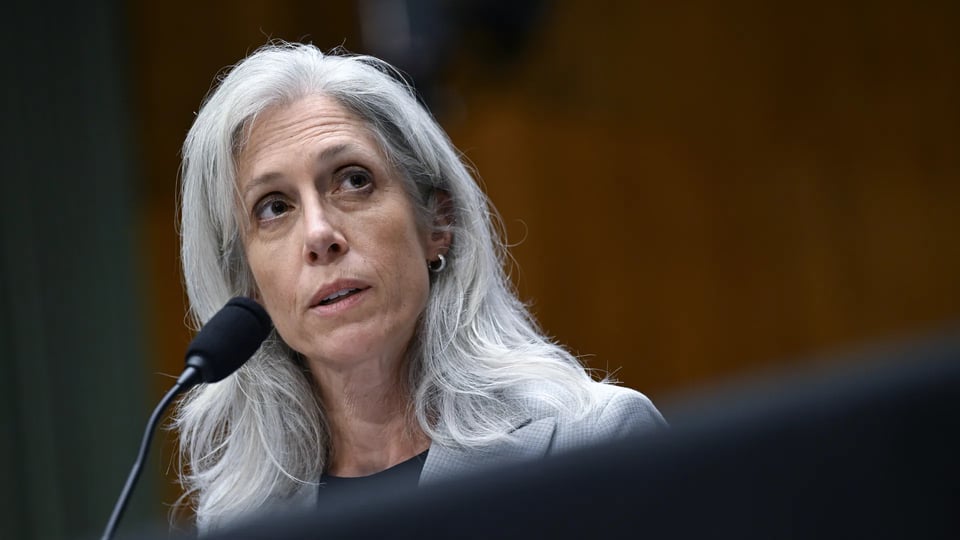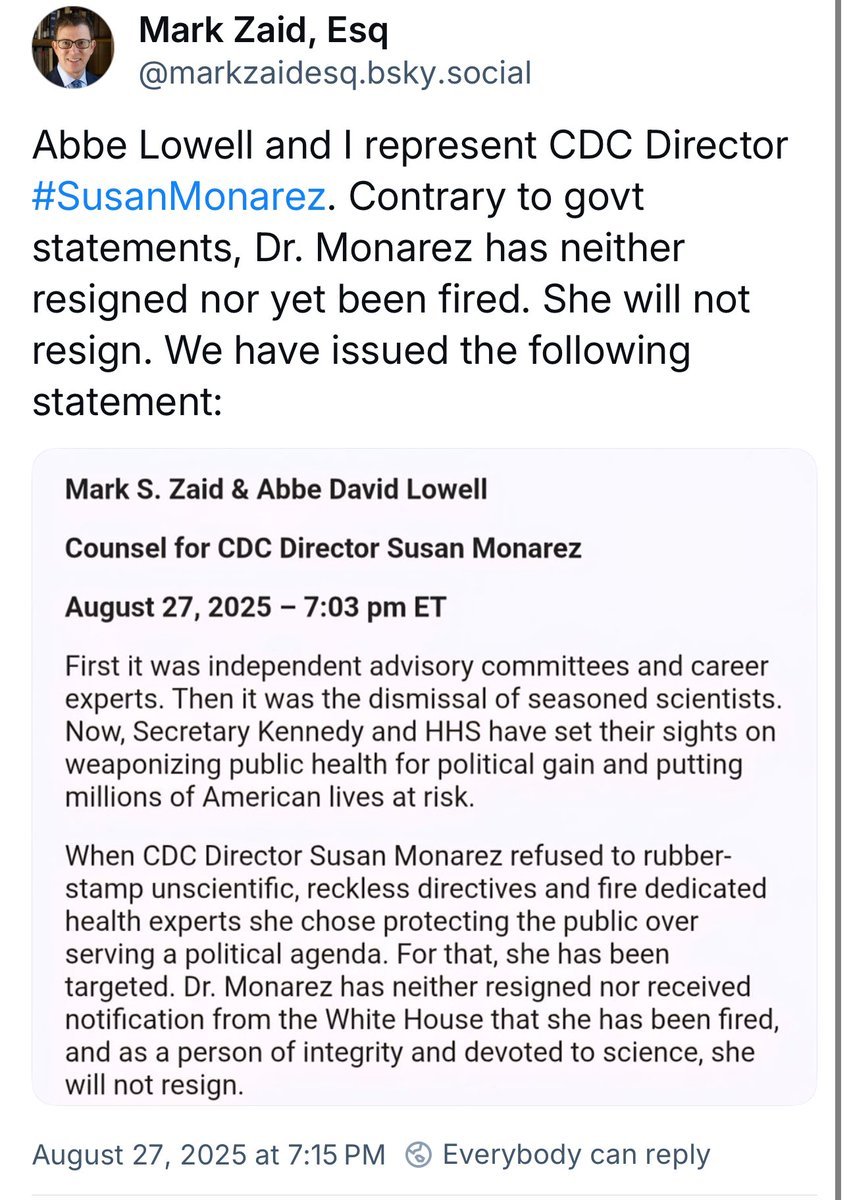Thursday, August 28, 2025. Annette’s Roundup for Democracy.
Trump is always crazy.
So is his sycophantic cabinet.
What, Exactly, Was That Cabinet Meeting?

As hours ticked by, President Trump played reality television host — “This has never been done before!” — as his cabinet members offered praise. It was a glimpse of how he runs his presidency.
What do you get for a president who commands everybody’s attention, all of the time?
For members of President Trump’s cabinet on Tuesday, the answer was apparently this: a televised meeting at the White House that lasted almost half the workday.
In front of a wall of cameras, the old “Apprentice” host offered a clear window into the way he was running his administration, starting with an ego that appeared to need frequent feeding, and blustery stamina: “This has never been done before,” the president said at one point, in between calling on secretaries to speak and marveling over the waiting reporters’ abilities to hold microphones and cameras aloft for several hours.
There in the Cabinet Room — which is starting to take on the gilded-cage look of Mr. Trump’s Oval Office — all of the president’s men and women took their turns, each working a little bit harder than the last to offer Mr. Trump praise and to assure him that they were working to tackle his long list of grievances.
That list is as ever-growing as it is specific to Mr. Trump’s pet peeves and political ambitions. It includes preventing “transgender for everybody” in American sports; using a heavy hand — perhaps the death penalty, the president said — to crack down on violent crime; the ongoing threat of windmills; the foul state of traffic medians; the speed with which water flows; and the attempts at securing peace deals for as many as seven international wars, a number that seems to grow by the day.
Mr. Trump, a pop culture maven, had relatively little to say about what was arguably the biggest news of the day: the engagement of Taylor Swift, whom he has publicly insulted and threatened for not supporting him, to Travis Kelce, the Kansas City Chiefs tight end. The event rattled on for so long that the president was asked to comment on news that had broken during the meeting.
“I wish him a lot of luck,” Mr. Trump said. “I think he’s a great guy, and I think that she’s a terrific person. So I wish them a lot of luck.”
The cabinet event was billed as a celebration of American workers ahead of Labor Day. Yet with a running time of three hours and 15 minutes, it would be considered a wildly inefficient meeting at just about any other workplace. The actual policy menu was just gristle in comparison to the red-meat politics, but for an afternoon, the Trump White House really was as radically transparent as Mr. Trump likes to say it is.
“There’s something really nice about just, you know, the openness of what we’re doing,” Mr. Trump mused as he closed the gathering out. “It’s government.”
He also seemed interested in dangling the idea that, at any moment, his cabinet members could be humiliated on national television: “Each one of these people spoke,” Mr. Trump said, apparently happy (whew!) with their performances. “If I thought one of them did badly, I would call that person out.”
He even threw them a compliment for torching their daily schedules: “These people are very busy!”
As the hours ticked by, Mr. Trump’s cabinet members highlighted the cost — in hours, in money, perhaps in karma — of keeping a seat at his table. And many did so while testing the apparently imaginary boundaries of the Hatch Act, which prohibits federal employees from engaging in political activities on the job.
The updates ranged from enthusiastic — Lori Chavez-DeRemer, the labor secretary, implored the president to come to her agency to look at his own “big, beautiful” face on a banner — to servile, and they went on for hours.
Occasionally, policy peeked in, but only in a way that allowed Mr. Trump to tack on his own thoughts or to take a hard right turn. Robert F. Kennedy Jr., the onetime presidential challenger and current health and human services secretary, issued an update about shrimp contaminated with radioactive material, accusing South Asian nations of “dumping shrimp” that was then packaged and sold at Walmart.
“You are going to save the whales,” Mr. Kennedy, who once sawed the head off a whale and drove it home, said while railing against the dangers of wind farms and wind energy, a long-held peeve of the president’s.
Mr. Kennedy then engaged Mr. Trump in a back and forth about rates of autism in young boys, allowing the president to wonder aloud if there was “something artificially causing this, meaning a drug or something,” repeating a widely debunked theory that vaccines cause autism and opening it up to an even vaguer interpretation.
In other moments, some of the truth behind all of that radical transparency revealed itself, like when Secretary of State Marco Rubio admitted that this year’s Labor Day held a special place in his heart.
“Personally, this is the most meaningful Labor Day of my life, as someone who has four jobs,” said Mr. Rubio, who in his spare time is Mr. Trump’s national security adviser, acting head of the National Archives and Records Administration and acting administrator of the U.S. Agency for International Development.
“That’s true,” the president replied.
And then there was Steve Witkoff, a billionaire whose praise was so slavish that even the president seemed to pick up on the overkill. During his turn, Mr. Witkoff, the president’s peace envoy, complimented Mr. Trump’s leadership in the Israel-Gaza conflict, a war that continued this week with Israeli strikes killing 20, including journalists, at a Gazan hospital. He suggested again that Mr. Trump should receive the Nobel Peace Prize he has long coveted.
“There’s only one thing I wish for: that the Nobel committee finally gets its act together and realizes that you are the single finest candidate since the Nobel Peace, this Nobel award was ever talked about,” Mr. Witkoff said.
When he was finished, the billionaire received a round of applause from his colleagues. During a later question-and-answer session with reporters and far-right news personalities, Mr. Trump circled back to his envoy and frequent golf buddy. Mr. Witkoff, Mr. Trump said, had reassured him that he was the only person who could solve the Russia-Ukraine war.
“I don’t know,” Mr. Trump said, “you’ve told me that a few times.”
The old reality television pro then broke the fourth wall. “Unless he was saying it just to build up my ego. But it’s not really. I have no ego when it comes to this stuff,” Mr. Trump said.
At another point, the president, keenly aware of the power and the perils associated with a brand name, said that he was interested in changing the name of a sweeping piece of legislation he had called the “big, beautiful bill.” He suggested that the fine print of the legislation was lost on the average American worker the cabinet had gathered to celebrate.
“I’m not going to use the term ‘great, big, beautiful,’” Mr. Trump said. “That was good for getting it approved, but it’s not good for explaining to people what it’s all about.”
He added: “It’s a massive tax cut for the middle class.”
Like much of what was said on Tuesday, this was transparent but not truthful: The legislation overwhelmingly benefits top earners, and has adverse effects for low-income households.
But never mind. The revolution was being broadcast on live television, in the Cabinet Room, for hours and hours. The president was in control.
For Mr. Trump, three hours of nonstop attention was enough. At least for the day. (New York Times).
If you want to watch this madness live, here is the link. 3+ hours. Happy to announce there wasn’t a big audience for this. The official White House YouTube stream of the Aug. 26 cabinet meeting shows roughly 240k views (live + replays).
Think of this as another thing to complain about when you call your elected officials.
Censorship has taken hold at the Smithsonian. I refused to play along.
Amy Sherald: I wouldn’t let the Smithsonian show my work. Trump keeps demonstrating why.
When a government starts deciding which stories museums can tell, it is not protecting history. It is rewriting it.
When the Trump White House announced its plans to “review” the Smithsonian (which includes 21 museums, research centers, an arboretum and a zoo), that statement, to some, may have sounded bureaucratic or even harmless. It is neither. When governments police museums, they are not simply policing exhibitions. They are policing imagination itself.
Philippe de Montebello, an art curator who previously directed the Metropolitan Museum of Art for 31 years, once called museums “the memory of mankind.” If that is true, then to manipulate museums is to manipulate who we believe we are. Control the memory and you control the future.
This country’s story has always been a contradiction. Slavery alongside freedom. Erasure alongside invention. Art carries what is too heavy for language to hold. And museums, at their best, give us the full picture rather than the flattering one. That independence is not ornamental. It is as vital to democracy as the freedom of the press.
History shows us what happens when governments demand that museums perform loyalty. Nazi Germany weaponized them. So did the Soviet Union.
Federal interference in cultural and civic life has a long precedent. When President Woodrow Wilson took office in 1913, he systematically resegregated federal workplaces that had been integrated since Reconstruction and sidelined or dismissed Black employees, calling such moves “beneficial” and “in the best interest” of both races. But not only did he impose segregation in federal government offices, the Smithsonian Institute Archives reports Wilson “pressured the institution to impose Jim Crow” but that “its partial autonomy from the federal government allowed it to resist these pressures.”
In 1929, during Herbert Hoover’s administration, that partial autonomy gave two Smithsonian commissioners, the Rev. Anson Phelps Stokes Jr. of the Washington Cathedral and Dr. Emmett J. Scott of Howard University, just enough meaningful space to resist the Jim Crow restrictions established by Wilson and bring in “American Negro Artists,” a traveling exhibition of 51 works by 27 Black painters and sculptors.
Even so, to protect white patrons’ sensibilities, “American Negro Artists” was relegated to a dimly lit foyer. Yet, its impact was profound. By centering Black artistry, the show subtly challenged prevailing racial hierarchies and asserted that African American culture belonged in the national story. Thousands attended, with African American visitors making up the majority, which proved that even under constraints, museums can expand public imagination and reshape political narratives. Indeed, when left free to follow scholarship rather than political mood, museums can expand imagination, challenge hierarchies and strengthen democracy.
Constraining museums does not protect the public. It impoverishes us. In 1995, the Smithsonian’s Enola Gay exhibition was gutted after political backlash over its depiction of the human cost of the atomic bomb. In 2010, Congress pressured the institution to alter its groundbreaking LGBTQ+ exhibition “Hide/Seek.” Now, the Trump administration wants to impose “Americanism” as a litmus test. The word may sound patriotic to some people, but it’s meant to function like a leash.
I know this pressure personally. In July, I announced my decision to keep my exhibition “American Sublime” from being installed at the Smithsonian’s National Portrait Gallery after the attempted censorship of my painting Trans Forming Liberty, which presents the Statue of Liberty as a Black trans woman. The gallery informed me that it had concerns about that painting.

As I said in a statement at the time, “While no single person is to blame, it’s clear that institutional fear shaped by a broader climate of political hostility toward trans lives played a role. This painting exists to hold space for someone whose humanity has been politicized and disregarded. I cannot in good conscience comply with a culture of censorship, especially when it targets vulnerable communities.”
Though a spokesperson from the Smithsonian disputed my claim that my work was being policed, multiple incidents since then — including mentions of Trump’s impeachments being removed from an exhibit on presidential impeachments and his complaint last week that the Smithsonian is “OUT OF CONTROL” and focuses too much on “how bad Slavery was” — help make my point. It became clear during my exchanges with the gallery how quickly curatorial independence collapses when politics enters the room.
Museums are not stages for loyalty. They are civic laboratories.
(MSNBC)
One more thing.
Amy Sherald is perhaps best known for creating the Official Portrait of First Lady Michelle Obama. This commission from the National Portrait Gallery made her the first African American ever to receive a presidential portrait commission from the Portrait Gallery, along with Kehinde Wiley who was similarly commissioned to paint the Official Portrait of President Obama.

Something worth seeing.
Love the new Trump banner outside the DOJ. pic.twitter.com/7CNNcmMmaP
— Eric Swalwell (@ericswalwell) August 27, 2025
Trump and Kennedy reject any and all dissent from appointees.
Colleagues fight back. Will the GOP Congress ever join them?
Despite Trump attempt at firing her, Lisa Cook, Fed Governor, has committed colleagues.
Fed Slaps Back at Trump and Says Keep Your Hands Off Cook

The Federal Reserve has clapped back at President Donald Trump after he moved to fire an independent governor based on an unproven allegation made by a MAGA acolyte.
As the president doubled down on his bid to unseat Governor Lisa Cook - which would allow him to install his own board member and seize majority control of the Central Bank - the Fed issued a rare, pointed statement pushing back against the power grab.
“Congress, through the Federal Reserve Act, directs that governors serve in long, fixed terms and may be removed by the president only ‘for cause’,” a Federal Reserve spokesperson said, citing the need to have a valid, justifiable reason for termination.
“Long tenures and removal protections for governors serve as a vital safeguard, ensuring that monetary policy decisions are based on data, economic analysis, and the long-term interests of the American people. The Federal Reserve will continue to carry out its duties as established by law.”
The comments came after Trump took the unprecedented step this week of writing a termination letter to Cook, which he posted on social media, telling her she would be removed from her position “effective immediately” over allegations of mortgage fraud.
The allegation was made by MAGA ally Bill Pulte, the head of the federal Housing Finance Agency, who has separately also referred New York’s Democrat Attorney General Letitia James and California Democrat Senator Adam Schiff to the department on similar mortgage fraud allegations.
Targeting Cook is a dramatic escalation in Trump’s longstanding feud with the Federal Reserve and its chairman Jerome Powell, who the administration has repeatedly attacked for not reducing interest rates.
While the president has opted not to sack Powell before his term expires next year, he has made no secret of his desire to stack the board with more people who are aligned with his views.
Removing Cook, who was appointed under Joe Biden to serve until 2038 and is the first Black woman to serve as a Fed governor, would help him fulfill this goal.
“We’ll have a majority very shortly and that’ll be great,” he said on Tuesday, referencing his desire to control the direction of the independent bank’s monetary policy.
Speaking to reporters at the White House on Wednesday morning, Kevin Hasset, the Director of the National Economic Council, said Cook should go on leave until the accusations are resolved.
“The fact that she is not doing that suggests that she is partisan and is trying to make a partisan stance which is contrary to the independence of the Fed,” he said.
Treasury Secretary Scott Bessent also weighed in on Fox News’ Mornings with Maria, saying there were “two kinds of people” - those who think Trump was putting “undue pressure” on the Fed, and those “who think that if a Fed official committed mortgage fraud, this should be examined and they shouldn’t be serving as one of the nation’s leading financial investigators.”
“What we haven’t heard from Ms. Cook is we haven’t heard her say ‘I didn’t do it.’ She just keeps saying the president can’t remove her’,” said Bessent.
Cook, however, says she is going nowhere.
“President Trump purported to fire me “for cause” when no cause exists under the law, and he has no authority to do so,” she said.(The Daily Beast)
“I will not resign. I will continue to carry out my duties to help the American economy as I have been doing since 2022.”
Susan Monarez, head of the CDC, fired yesterday for disagreeing with Bobby Kennedy on COVID vaccinations, has committed colleagues too.
NEW: After reports surfaced that she had been fired, lawyers for CDC Director Susan Monarez say she "has neither resigned nor received notification from the White House that she has been fired, and as a person of integrity and devoted to science, she will not resign."
— Kyle Griffin (@kylegriffin1) August 28, 2025
Susan Monarez out as CDC director, HHS announces.
Centers for Disease Control Director Susan Monarez has abruptly left the post just weeks after being sworn in, the Department of Health and Human Services announced on Wednesday — a claim that was immediately disputed by her lawyers.

Why it matters: The dispute left the leadership of the agency in turmoil as a wave of high-level departures gutted the leadership of the agency that's responsible for protecting the nation's public health.
The latest: After HHS announced on X that Monarez is "no longer director of the Centers for Disease Control and Prevention," attorneys Mark Zaid and Abbe Lowell posted on X Wednesday night that Monarez "has neither resigned nor received notification from the White House that she has been fired."
Driving the news: The CDC's chief medical officer Debra Houry resigned her position, according to internal emails viewed by Axios.
Daniel Jernigan, CDC's director of the National Center for Emerging and Zoonotic Infectious Diseases and the CDC's director of the National Center for Immunization and Respiratory Diseases Demetre Daskalakis, also resigned their posts on Wednesday, according to the emails.
What they're saying: "I am not able to serve in this role any longer because of the ongoing weaponizing of public health," Daskalakis wrote in an email.
"Vaccines save lives — this is an indisputable, well-established, scientific fact," Houry wrote in a separate email.
"I am committed to protecting the public's health, but the ongoing changes prevent me from continuing in my job as a leader of the agency."
Monarez clashed with HHS Secretary Robert F. Kennedy Jr. over COVID vaccine policy changes and tried to get Sen. Bill Cassidy (R-La.) to intervene after Kennedy urged her to resign, the Washington Post reported.
Requests for comment from HHS and the White House were not immediately returned.
Monarez's departure comes the same day HHS announced it will limit who is eligible for COVID vaccines.
During her brief tenure, the agency was targeted in an attack on its Atlanta headquarters by a gunman influenced by anti-vaccine rhetoric and moved ahead with hundreds of job cuts.
Between the lines: Monarez was confirmed to the job on July 29 after being nominated in May by President Trump following the withdrawal of his first pick Dave Weldon was pulled.
She walked a fine line during hearings in her support for vaccines while not contradicting Kennedy.
Catch up quick: Her departure continued a series of abrupt personnel changes throughout federal health agencies that saw FDA's lead vaccine regulator Vinay Prasad return to his post earlier this month after he unexpectedly departed in late July. (Axios)
One more thing.
RFK Jr. had previously removed all 17 members of the CDC’s vaccine advisory committee (ACIP), replacing them with critics of vaccination and reshaping vaccine eligibility.
Monarez was fired for refusing to ‘rubber-stamp unscientific, reckless directives’, lawyers say.
FYI, Monarez lawyers are also Lisa Cook lawyers.

AI is here. What will it mean to you?
This is an hour podcast on AI (sometimes called AGI, for Artificial General Intelligence) with Reid Hoffman, founder of Linked-in.
A revolution is here. You can’t stop it. You need to know how too use it. This podcast may help.
Here’s a taste of what you will hear.
How you can evolve with AI
If you’re a knowledge worker watching the progress of AI—with curiosity, skepticism, excitement, or fear—this is what Reid wants you to know:
AI is the new standard. “I can't be a professional and say, ‘I don't use computers,’ ‘I don't use smartphones’...AI is just the amplification of that.”
Your job isn’t going away, just changing. “I think a lot of jobs won't go away; I think they'll transform—and so the question is, are you adapting and transforming with them?”
Don’t forget to experiment, for work and play. “The best way [to learn] is just start engaging with it in some seriousness. It's fine, for example, to go to ChatGPT and say, ‘Give me a sonnet for my friend's birthday’…Great. Do that. But also use it for things that you are serious and earnest about—and you may find that some of them it's not ready yet, but you'll find that some of them it is.”
Best of the Pod: How to Prepare for AGI According to Reid Hoffman - YouTube
Andy Borowitz has some serious words to share. Seriously.

How NOT to Stop Trump - by Andy Borowitz
WARNING: This post contains useful information.)
The political spam clogging my phone each week makes me nostalgic for the days when the only people begging me for cash were Nigerian princes.
The midterm elections are a huge opportunity to stop Trump’s agenda. That’s exactly what voters did to Ronald Reagan in the 1986 midterms, and we can do it again.
Before you accuse me of drinking whatever Pete Hegseth chugs when he logs on to Signal, consider this: last night in a special Iowa Senate election, Democrat Catelin Drey won by over ten points in a district that Trump won by eleven in 2024.
I know that math isn’t Trump’s strong suit, so I’ll do it for him: that’s a swing to the Democrats of over 21 points. And with her victory, Drey smashed the Republican supermajority in the Iowa Senate.
As the Des Moines Register reported, “Drey's victory is the latest in a string of positive special election results for Democrats this year that will give the party hope that it can claw back seats in the 2026 midterms.”
Decision Desk HQ
In short? We can do this.
So: if you want to make campaign donations that count, where should you send your dollars?
I consulted experts on this subject and got their advice. The following guide is by no means exhaustive, but I hope it helps.
Don’ts
Don’t give to a PAC using crummy/deceptive fundraising tactics (anyone claiming to have 3x matches, or claiming that if you don’t give right now the world will explode)
Don’t give to a PAC you’ve never heard of before just because they have a vague anti-Trump-sounding name
Don’t give to a candidate running in a district that Trump won by a billion points in 2024 and a Democrat isn’t going to flip; for example, don’t give to a vanity candidate running against Marjorie Taylor Greene
Don’t give to a group that you don’t know anything about and is sending you random messages
Dos
Give to a candidate running in Virginia in their off-cycle election (like Abigail Spanberger for governor)
Money donated directly to a candidate will often go further than to a PAC. Candidates can buy airtime at a cheaper rate than PACs, although many PACs still do valuable work
If you give to a candidate, make sure they’re running in a winnable seat. These lists aren’t perfect, but the Cook Political Report rates the competitiveness of every House race. Your money is best spent on races in the “lean” or “tossup” category
Pick a candidate you think does great work and give them a monthly recurring donation—just set it and forget it. Recurring donations are great because they help organizations plan their future budgets well. So $10 over 12 months is often worth more to a campaign than $120 up front, because their budget-making process requires accurate forecasting
If all of this sounds too complicated, here’s one simple thing you can do: give to Jon Ossoff of Georgia. He’s the most vulnerable Democratic Senate incumbent. You can give him a recurring donation for 18 months and that’ll take him through Election Day. If that’s all you do, that would be pretty great!
And one enormous DON’T:
Don’t say, “There won’t be midterms, because Trump is going to declare martial law and cancel all elections from now on.” That’s a right-wing narrative designed to make you feel hopeless and prevent you from donating, volunteering, and voting. Don’t fall for it!
Instead, let’s do some critical thinking: if there won’t be any midterms, why are Republicans scrambling to gerrymander in states like Texas? I’ll tell you why: they’re terrified of losing control of the House—and with your help, they will.
A final note: if you have friends and/or family who might find this guide useful, please share it with them! And thanks, as always, for your support. (The Borowitz Report)
One more thing.
Borowitz recommends this-“Give to a candidate running in Virginia in their off-cycle election (like Abigail Spanberger for governor).”
Show you got the message.
Make sure Spanberger wins, donate here.